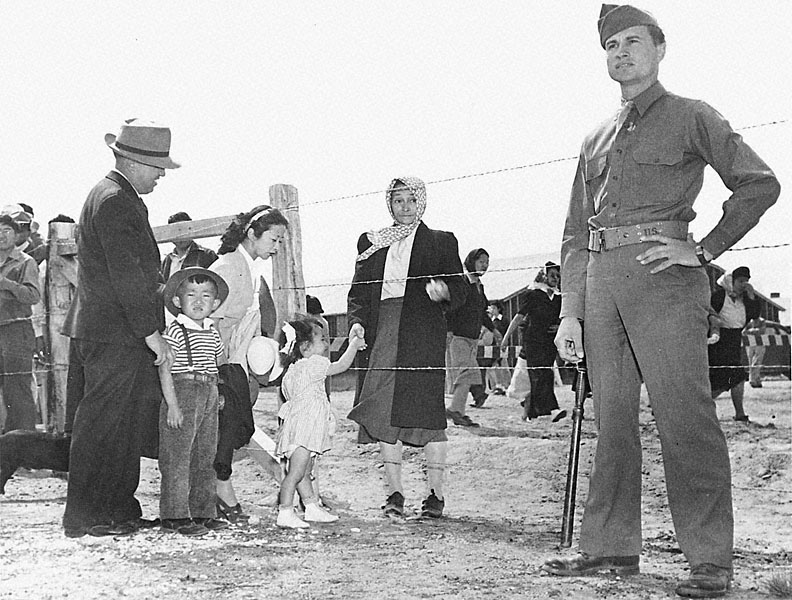- Catalog No. —
- OrHi 44601
- Date —
- c. 1942
- Era —
- 1921-1949 (Great Depression and World War II)
- Themes —
- Government, Law, and Politics, Race, Ethnicity, and Nationality
- Credits —
- Oregon Historical Society
- Regions —
- None
- Author —
- Unknown
Heart Mountain Relocation Camp
This World War II photograph shows a Japanese American family at the Heart Mountain Relocation Center, north of Cody, Wyoming, one of the camps where the United States government imprisoned West Coast Japanese immigrants and Japanese Americans. More than ten thousand people were imprisoned at Heart Mountain, where the barracks were roughly built and poorly insulated and the landscape was barren. Most of Oregon’s Japanese and Japanese American population were held at the Minidoka Relocation Center in southern Idaho, while others went to the Tule Lake Relocation Center in northern California.
After Japan attacked Pearl Harbor on December 7, 1941, the U.S. government declared that immigrant Japanese—Issei—were “enemy aliens” and many Issei men were detained by the FBI. On February 19, 1942, President Franklin D. Roosevelt issued Executive Order 9066, authorizing the U.S. Army to remove Issei and American-born Japanese who were citizens—called Nisei—from the West Coast.
The order devastated Oregon’s Japanese community, as people were forced to sell their property at below-market prices and to abandon their businesses. The army first took internees to assembly centers, where they lived for months before being transported to permanent camps.
Further Reading:
Azuma, Eiichiro. “A History of Oregon’s Issei, 1880-1952.” Oregon Historical Quarterly 94, 1993-4: 315-67.
Olmstead, Timothy. “Nikkei Internment: The Perspective of Two Oregon Weekly Newspapers.” Oregon Historical Quarterly 85, 1984: 5-32.
Burton, J., M. Farrell, F. Lord, and R. Lord. “Confinement and Ethnicity: An Overview of World War II Japanese American Relocation Sites.” Western Archeological and Conservation Center National Park Service Publications in Anthropology 74, 1999.
Written by Kathy Tucker, Oregon Historical Society, 2002; revised 2021.
Related Historical Records
-
Japanese Evacuees, Portland Assembly Center
In May 1942, Portland-area Japanese and Japanese Americans—both Issei (first generation) and Nisei (second generation) —were evacuated to hastily constructed temporary living quarters in the Pacific International Livestock …

-
Japanese Forced Removal and Incarceration
Portland lost thousands of potential workers in the spring of 1942, when its residents of Japanese descent, were forcibly removed and incarcerated. During the war, 120,000 U.S. residents …
